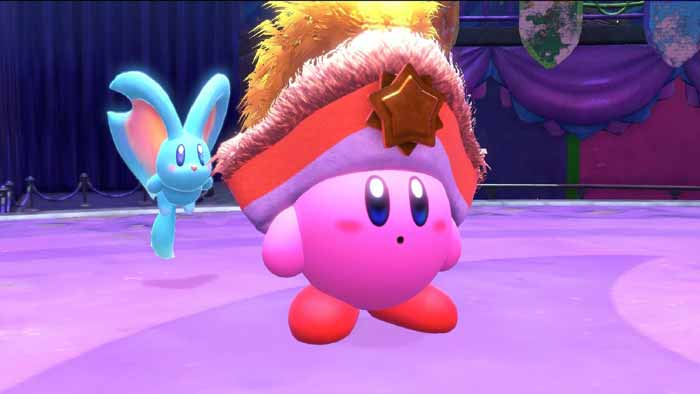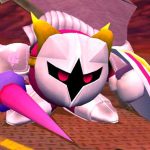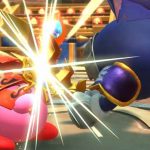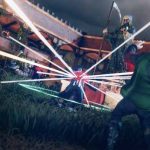Kirby and the Rainbow Curse, known as Kirby and the Rainbow Paintbrush in British English, is the sole Kirby title released for the Wii U in 2015.
Kirby and the Rainbow Curse Overview
Kirby and the Rainbow Curse is a rolling, dashing and jumping game where you draw rainbow ropes for Kirby to follow. You journey through the clay world on a mission to restore the colour that has been drained by a mysterious force. You are guided along by your paintbrush friend, fighting enemies, destroying bosses and avoid hazards.
Unlike other platform games, you use the stylus and the Wii U GamePad touchscreen to progress through the levels. You draw lines that determine which direction Kirby will roll, fall and dash. These ink lines can also block lasers, enemies and other hazards. However, you need to be careful how you draw as the ink runs out if you use too much in a short period of time.
As you progress you collect stars. These are strategically placed in rows which you can guide Kirby to dash along with your ink. Collect enough of the stars and you can use the StarDash power-up which temporarily increases your size, your speed and strength.
There are hidden treasure chests in the levels which contain music tracks and clay figures of classic Kirby characters. For certain levels, you can use specific Amiibo characters which will give you abilities or power-ups such as more health bars or increased speed.
This game has a playing style similar to one of the previous Kirby games, Kirby Canvas Curse (2005) for the Nintendo DS, where you also had to use a stylus to draw a path for Kirby. Kirby and the Rainbow Curse is unique, however, because of its clay-like visuals and longer levels. It is suitable for the family to play together or as a solo adventure
Kirby and the Rainbow Curse: Level 4-Boss – Blue Sky Palace – Sky-High Whispy Woods
Head into the boss room and you’ll notice Whispy Woods is looking a bit different. It can only be damaged with a Star Dash so you’re going to have to collect 100 Point Stars before you can do any damage. Dodge around the spiked balls and collect Point Stars until you have enough to perform a Star Dash.
When you have 100, Star Dash into the tree and repeatedly tap on Kirby to damage it. You can take it out in three Star Dashes (and yes, you can Star Dash through the spiked balls).
You’ll probably take out the boss before the blue centipede pictured above shows up. If you dash into it, it will split into a few segments to pester you.
Summary of Kirby and the Rainbow Curse
Do you have the magic touch? Then guide Kirby as he sets off on grand adventures in a hand-sculpted clay world. Draw lines on the touch screen of the Wii U GamePad controller to create rainbow-colored clay ropes to move Kirby around freely, or tap him to attack enemies or blast through obstacles. Transformations include a submarine, rocket and tank. In underwater levels, Kirby dons a swim mask. If his power level gets too low, a clay bandage appears on his head.
FEATURES:
- Kirby comes to life in a world of clay, which creates a beautiful backdrop for Kirby’s adventure.
- You take control of Kirby with the stroke of a stylus and draw on the GamePad touch screen to guide Kirby through the world.
- Use the GamePad to control Kirby’s many transformations in unique new ways.
- The intuitive drawing mechanic is a spiritual successor to Kirby: Canvas Curse for Nintendo DS that builds on the game play and takes it in a new direction.
What Parents Need to Know About Kirby and the Rainbow Curse
Parents need to know that Kirby and the Rainbow Curse is an adventure game that features some mild fantasy violence. Specifically, the pink protagonist can transform into a couple of vehicles (tank, sub, rocket) that can shoot missiles at enemies that disappear when struck; it should be known that combat isn’t the primary focus of the game. Although it does feature a tutorial that explains the controls very well, interacting with Kirby isn’t as intuitive as it could be, which could increase frustration in players. Kids also might ask parents to buy amiibo characters, which are optional action figures that can be used in the game to unlock special abilities.
Kirby and the Rainbow Curse Modes
- Story Mode follows the story plot. In each level (excluding boss levels), there are four or five treasure chests for Kirby to collect. The treasure chests contain figurines and music.
- Challenge Mode contains 48 challenge rooms for Kirby. Kirby has 15 seconds each in each section to collect the treasure chests. One-Minute Challenges have four sections to complete. Survival Challenges have 12 sections to complete, but if Kirby does not collect the treasure chest in one of the sections, the challenge automatically ends.
- Figurine Showcase shows all of the unlocked figurines. There are figurines of the protagonists, enemies, and even characters from other Kirby games.
Secret Diary contains Elline’s secret diary pages. The diary is about the plot as well as Kirby’s life in her perspective. - Music Room contains music from this game as well as the unlocked music from past Kirby games.
Kirby and the Rainbow Curse tips to shape a hero
Controlling Kirby is itself a bit of a challenge, forcing you to think less about direct control of a character and more about how the lines you draw affect his movement. Not having direct control of a character is one thing, but knowing you have to force them to move in a very specific way, sometimes very quickly, without actually moving them directly is what separates Rainbow Curse from the rest of the series. The difficulty doesn’t ramp up until later levels, but the design of even the early levels quickly trains you on the specifics of line placement and how to best get Kirby to move where you want him to go. It’s a tricky, yet very rewarding core mechanic that feels just as satisfying here as it did ten years ago.
There’s a number of trophies (a la Smash Bros.) to collect, each with a witty description. Some descriptions simply describe the character in question in a simple summary, but others seem to play with expectations. Secret Diary entries, another collectible, are written and drawn in Elline’s perspective, chronicling her adventure with Kirby in Dream Land. – Eric Albuen
Eventually you’ll be drawing lines to move Kirby quickly from an enemy, to an item, to a secret and back to the main path without breaking a sweat. The gradual ramp up in challenge on top of the numerous bonus collectibles and secrets throughout each level provides you plenty of opportunities to test your skills while also slowly understanding the subtlety of the core mechanics. The formula is just as rewarding in Kirby and the Rainbow Curse as ever before.
Canon is a term used to designate events, objects, or characters that are indisputably part of a fictional narrative, and congruent with other stories in that narrative. In terms of the Kirby series, the term would be used to describe anything that has definitively occurred in the storyline of the main series.
Unless stated otherwise, sub-games and games that expand on sub-games are non-canon in the Kirby universe.
Kirby has developed a lot of lore in his long history and there’s actually a lot of things to catch up on that might be important. That might be surprising for the series that seems so cute and cuddly, but the callbacks and connections are a big appeal to fans.
Canonicity. The sub-game is mostly non-canon, being a rerun of the main sub-games of Kirby Super Star, but as Meta Knight.
Also read:
- How To Check Aram MMR In League Of Legends? How Is Aram Calculated?
- How To Defeat Maliketh The Black Blade In Elden Ring?
- How to Play Wordle? Is it a Real Game or a Puzzle?
- Wordle FAQ : The Complete Guide and Tips + Solver, Answer and Clues
- Solving Wordle Game using Information Theory and Entropy
- Best Games like Wordle to Play Unlimited : Similar Free Puzzle Games












